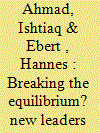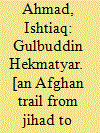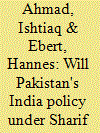|
|
|
Sort Order |
|
|
|
Items / Page
|
|
|
|
|
|
|
| Srl | Item |
| 1 |
ID:
138497


|
|
|
|
|
| Summary/Abstract |
The election of new governments in Pakistan and India in 2013 and 2014, respectively, has sparked controversies about the likely trajectory of the enduring rivalry. Emerging individual and domestic conditions reportedly created new opportunities for incremental rapprochement. Equipped with strong political mandates and backed by powerful constituencies, Pakistan's Nawaz Sharif and India's Narendra Modi initially set out to stabilize and revive their countries’ fragile economies and declared improved bilateral ties as a key precondition for implementing their economic agendas. However, mutual recriminations and border tensions resurfaced soon to prevent the revival of the stalled diplomatic dialogue in late 2014. Drawing on a thorough review of research on rivalry maintenance and termination and, in particular, the assumptions of the punctuated equilibrium model developed by Paul Diehl and Gary Goertz, this paper demonstrates how the conflict's structural complexities are likely to persist and undermine the chances for conflict resolution in the years ahead. The prevalent role of the army and a vibrant anti-Indian Islamic ideology in Pakistan, the persistence of a conflict lobby in India, lingering territorial feuds and ever increasing power asymmetries between the two countries, and decreasing third-party mediation in the Indo-Pakistani conflict will likely suffocate any initiative, however well-intended or pragmatic it may be. Even if bold leadership manages to revive a comprehensive peace process, it would have to be based on systematic confidence building measures in order to make it resilient to crises.
|
|
|
|
|
|
|
|
|
|
|
|
|
|
|
|
| 2 |
ID:
065497


|
|
|
|
|
| Publication |
Islamabad, Pan Graphics (Private) Ltd., 2004.
|
| Description |
xii, 151p.pbk
|
| Standard Number |
9698796002
|
|
|
|
|
|
|
|
|
|
|
|
Copies: C:1/I:0,R:0,Q:0
Circulation
| Accession# | Call# | Current Location | Status | Policy | Location |
| 050110 | 958.1/AHM 050110 | Main | On Shelf | General | |
|
|
|
|
| 3 |
ID:
068000


|
|
|
|
|
| Publication |
Islamabad, Society for Tolerance and Educastion, 2004.
|
| Description |
x, 147p.
|
| Standard Number |
9698796010
|
|
|
|
|
|
|
|
|
|
|
|
Copies: C:1/I:0,R:0,Q:0
Circulation
| Accession# | Call# | Current Location | Status | Policy | Location |
| 050851 | 327.5405491/AHM 050851 | Main | On Shelf | General | |
|
|
|
|
| 4 |
ID:
081645


|
|
|
|
|
| Publication |
Islamabad, Society for Tolerance and Education, 2004.
|
| Description |
x, 147p.
|
| Standard Number |
9698796010
|
|
|
|
|
|
|
|
|
|
|
|
Copies: C:1/I:0,R:0,Q:0
Circulation
| Accession# | Call# | Current Location | Status | Policy | Location |
| 053369 | 327.5405491/AHM 053369 | Main | On Shelf | General | |
|
|
|
|
| 5 |
ID:
101754


|
|
|
| 6 |
ID:
126109


|
|
|
|
|
| Publication |
2013.
|
| Summary/Abstract |
The May 2013 parliamentary elections in Pakistan led to a stable government under the Pakistan Muslim League-Nawaz (PML-N). Prime Minister Sharif promised a shift of the country's India policy. Given his track record, the current pressing economic and security imperatives and recent improvements in Indo-Pakistan trade relations, the popular optimism is understandable and the first steps of rapprochement are to be expected. But structural factors such as growing asymmetries, the persistent role of the army in Pakistan's India policy and the rigid discourse of ideology undermine the potential for meaningful change. While a paradigm shift is therefore unlikely in the foreseeable future, a rare window of opportunity has opened for the new leadership to assert its authority and incrementally enhance new policies.
|
|
|
|
|
|
|
|
|
|
|
|
|
|
|
|
|
|
|
|
|